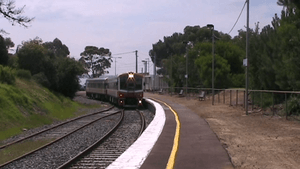Passing loop facts for kids

A passing loop is a special section of track on a single line railway or tramway. Imagine a road with only one lane. If two cars want to go in opposite directions, one has to pull over to let the other pass. A passing loop works like that! It's a place where the single track briefly splits into two or more tracks. This allows trains or trams traveling in opposite directions to pass each other safely. Sometimes, passing loops are also called "passing sidings" or "crossing loops." They are super important for keeping trains moving and avoiding long delays.
Contents
What is a Single Track Railway?
Most busy railway lines have two tracks, one for trains going in each direction. This is like a two-lane highway. But some railway lines, especially in less busy areas, only have a single track. This saves money and space. The challenge with a single track is that only one train can use it at a time in any given section. If two trains are heading towards each other on a single track, they would crash!
Why Do We Need Passing Loops?
Passing loops solve the problem of single-track lines. Without them, trains would have to wait at the start of a single-track section until the entire line was clear. This would cause huge delays. Passing loops allow trains to share the single line efficiently.
How Passing Loops Work
When two trains need to pass each other on a single track:
- One train pulls onto the extra track of the passing loop.
- It waits there while the other train passes by on the main track.
- Once the other train has gone past, the waiting train can then move back onto the single main track and continue its journey.
This clever system means that trains don't have to wait for the entire line to be clear. They only need to wait for a short section.
Where Are Passing Loops Found?
Passing loops are often built at stations. This is handy because trains might already be stopping there to pick up or drop off passengers. It's a good place for them to wait for another train to pass. However, passing loops can also be found in other places along a single track, even far from a station. Some passing loops can be very long, allowing fast express trains to overtake slower local trains.
Images for kids
-
Casey Jones as depicted on a 3 cent postage stamp issued by the United States Postal Service
-
Trains in a passing loop at Penryn railway station in the United Kingdom
-
Passing sidings in North America can be very long. This one in Bolton, Ontario – the track on the right – measures some 3.5 km.
-
A short passing track on a funicular in Pennsylvania







